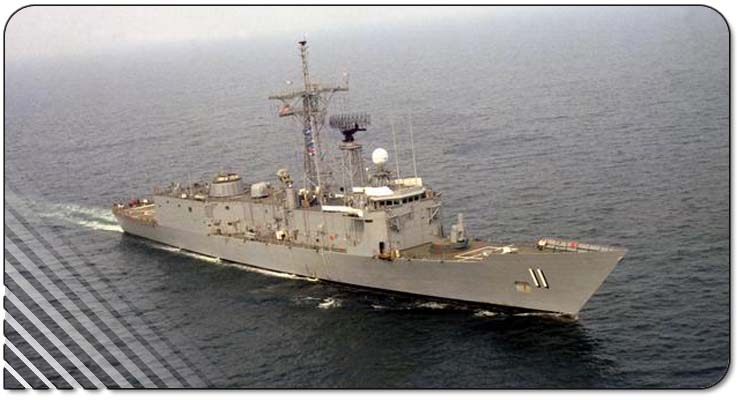Namesake:
Admiral Joseph J. Clark
"Part Cherokee, part Southern Methodist, but all fighter," Admiral
Joseph James (Jocko) Clark, bold aircraft carrier commander and World
War II hero, was thus described by the Navy historian Samuel Eliot
Morison.
The legendary admiral forged a distinguished reputation as a fearless,
aggressive leader and brilliant tactician during a 40 year career from
service as Deck Officer, to pilot, to Fleet Commander.
Admiral Clark served as Executive Officer of the USS YORKTOWN; then he
was designated the first Commanding Officer of two new carriers: USS
SUWANEE and the new USS YORKTOWN. Later during World War II, he
commanded a carrier task group. During the Korean War he commanded TASK
FORCE 77, and was eventually assigned as Commander of the Seventh
Fleet.
During World War I, Admiral Clark served on board the cruiser USS NORTH
CAROLINA on Atlantic convoy duty. Subsequently, he served on board the
USS AARON WARD, which was built at the Bath Iron Works, as was the ship
that bears his name. Admiral Clark assumed command of the destroyer USS
BROOKS in 1921. In 1925 he was designated a Naval Aviator, and thus
commenced the chapter of his career in which he helped to pioneer
developments in aviation tactics and doctrine that eventually proved
successful in World War II. He was advanced to the rank of Admiral on
the basis of the many citations he received in combat during World War
II.
Admiral Clark retired from active duty on 1 December 1953. He died 13
July 1971 in St. Albans, New York.
|
Ship's Crest:
 Description
of Coat of Arms:
The navy blue and gold on the shield of the coat of arms are the
traditional colors of the U.S. Navy and the Academy of which Admiral
Clark was a graduate. The pheons (arrowheads) represent the three wars
in which he served. The upper pheon and wings allude to the ship's
airborne weapons systems as well as to the Admiral's career-long
interest in naval aviation and his skill as a navigator and battle
tactician. The pheons further are symbolic of the weapons system of
CLARK, and the ability to strike the enemy from great distances. Description
of Coat of Arms:
The navy blue and gold on the shield of the coat of arms are the
traditional colors of the U.S. Navy and the Academy of which Admiral
Clark was a graduate. The pheons (arrowheads) represent the three wars
in which he served. The upper pheon and wings allude to the ship's
airborne weapons systems as well as to the Admiral's career-long
interest in naval aviation and his skill as a navigator and battle
tactician. The pheons further are symbolic of the weapons system of
CLARK, and the ability to strike the enemy from great distances.
The winged sea horse on the crest is a symbol of Admiral Clark's
career, relating to his close and long association with the air arm of
the U.S. Navy and to his foresight and mastery of the combat tactics of
air weapons systems. The thirteen stars denote his World War II
campaign participation, the collar bearing the cross represents his
highest award, the Navy Cross. The arrowhead refers to his home state
of Oklahoma and to his Cherokee Indian heritage; the decresent
simulates the initial letter of his last name.
|

